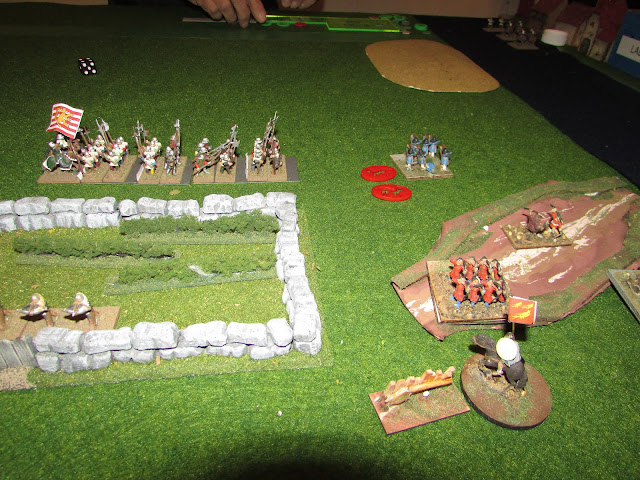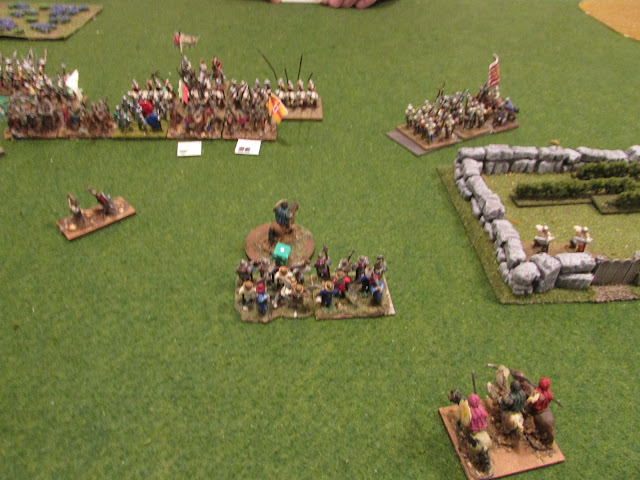A Headless Body Production
Venue: On Military Matters Bookstore. Owner Operator Dennis Shorthouse
Event: Team practice for the upcoming "The Weekend" team tourney.
Players: Phil Gardocki running Anglo Irish
Dennis Shorthouse, Early Swiss.
Game System: L'Art de la Guerre, 200 points per side.
Theme: Medieval team
The Forces:
Anglo Irish circa 1400: Commanders Larry, and his brothers Darryl and Darryl, all barely competent.Venue: On Military Matters Bookstore. Owner Operator Dennis Shorthouse
Event: Team practice for the upcoming "The Weekend" team tourney.
Players: Phil Gardocki running Anglo Irish
Dennis Shorthouse, Early Swiss.
Game System: L'Art de la Guerre, 200 points per side.
Theme: Medieval team
The Forces:
4 Galloglaich, Heavy Swordsmen, 2HW (Elite)
2 Billmen, Heavy Swordsmen, 2HW (Mediocre)
1 Foot Knight, 2HW (Elite)
4 Longbowmen,stakes
2 Longbowmen (Elite)
2 Irish Nobles, Heavy Cavalry
2 Light Cavalry, Javelin
4 Kerns, Light Infantry, Javelin
Breakpoint...22
The Corps will be called "Battles" as that was the naming convention for England in Medieval times.
Early Swiss, four pike, the rest Medium Swordsmen, all elite.
And a smattering of Crossbow armed lights.
Breakpoint...22
Dennis has a wonderful bookstore in Hopewell New Jersey,
that he has been running for many decades. Imagine going through a
library that is nothing but military history. If you don't think you
knew him, he is a long time supporter of Historical Miniatures Gaming Society, and held the coveted #1 spot in the dealers area for over 20 years. So if you have been to any of HMGS's events at the Lancaster Host, you probably have met Dennis at some time.
The Scenario:
Practice session for the upcoming "The Weekend" team tourney, Medieval period.
The Board:
The Anglo Irish have lose the initiative roll and will defend in the mountains
 |
| The light brown areas are fields |
 |
| The Anglo Irish have lose the initiative roll and will defend in the plains. |
 |
| Larry and Darryl's Battles are deployed. |
 |
| The other commander Darryl is either in ambush, or on a flank march. |
 |
| The Swiss army is impressively arrayed, and well supported by skirmishers. |
 |
| All those high point elite halberds and pikes, and still a break point of 22. |
 |
| A decently framed shot. Nice camp. About as mobile as the circle of stones the Anglo-Irish are carrying around. |
 |
| The Swiss had an unreliable commander that proved reliable this day. His Swordsmen invest the nearby vineyard, approaching the firing line. The Pike, with a shortage of command points, lags behind. |
 |
| Flank, or ambush? The Swiss have their question answered. |
 |
| Then the lights are charged by the elite longbow, with reasonable sounding names, who crushes the light horse, then pursues into their supports. |
 |
| This Swiss command is in range of the Anglo Longbow. Two of the halberd units are disordered. |
 |
| The main Anglo-Irish battle line awaits the pike. |
 |
| The Swiss Commander takes the practical approach, leave no living enemy behind you. |
 |
| The Swiss commander on the right is also practical. He pulls out his disordered halberdiers from the line to rally them out of range of the longbow. |
 |
| His remaining forces are either under cover, or behind skirmishers. But the casualties continue to pile up. |
 |
| The Swiss right flank command continues to be harassed. |
 |
| Larry leads his Billmen to a point to hold on the battle lines right. The Swiss halberdiers on the right can move very quickly through the plantation if they want to. |
 |
| Darryl decides to get away while the getting is good. But facing a shortage of command points, he has to leave one of his longbow-men behind. |
 |
| The Swiss charge supported, and one longbow unit is destroyed. |
 |
| The other Swiss halberdiers perform an about face and head for the main battle-line. |
 |
| The Swiss launch a half-hearted charge to run off some skirmishers, and it looks like they will have their battle-line in order for next turns charge. |
 |
| Ditto on the Swiss right. |
The charge of the Anglo-Irish main battle line slid left and hit the lone Swiss Halberd unit square.
Here is a question for everyone, because we are not sure this is done right. The initial gap between the one Swiss halberd unit and the pike was 25mm, more than half a stand. And this is how we ended after conforming. But is it right? This means the 15/25mm ratio is maintained down the line. So the Anglo foot knight, with the greener base in the middle, had most of his frontage (25mm) against the unit it is currently placed against.
Or would it have been correct to conform to break up the Anglo-Irish line and match the Swiss, element for element?
Here is a question for everyone, because we are not sure this is done right. The initial gap between the one Swiss halberd unit and the pike was 25mm, more than half a stand. And this is how we ended after conforming. But is it right? This means the 15/25mm ratio is maintained down the line. So the Anglo foot knight, with the greener base in the middle, had most of his frontage (25mm) against the unit it is currently placed against.
Or would it have been correct to conform to break up the Anglo-Irish line and match the Swiss, element for element?
 |
| Irish javelin men charge, causing Swiss lights to evade, providing another target for the longbow. |
 |
| The Anglo billmen, moving forward, but way too late for the party. |
 |
| Darryl two of his longbow safely behind fortifications, or in a position up hill on the gully. The third was dispersed to the winds. |
 |
| The fight at the main battle lines is pretty even as well. Both sides lose one unit, and both sides have one damaged. |
 |
| The other halberdiers decide to force the gully, and pick up a hit for their trouble. |
 |
| Irish Javelinmen flank charge a Swiss halberdier unit, but the dice roll a tie again. |
 |
| The situation hasn't changed here. |
 |
| Swiss arrogance, backed up by skill and ferocity are winning the day, as two longbow fall before their blades. |
 |
| On the Swiss left, their daring is not paying off, as a unit of halberdiers is shot away. |
 |
| Time's up. Final shot of the center. |
Since this is practice for the future team tournament in Lancaster, we held to the clock for the end game. The final score, the Anglo-Irish are at 13 points towards their break point of 22, while the Swiss were at 19 of 22. Because this was a practice for team play the game ended a bit differently then normal.
For instance, I would have charged my Billmen and heavy cavalry on the last turn, hoping for lucky dice rolls to take the Swiss to their break point of 22. But they are not good match-ups, as the Billmen are +1, Pike +2, the pike are elite, the billmen mediocre. Not a good plan. The Irish Nobles are just heavy cavalry, no other pluses. So they are net +2 vs the halberdiers with armor against the halberdiers +1 elite. Not a bad match up.
But if it went wrong? Then the Irish score could have shifted as much as 6 points. That decision effects the scores of the rest of the team. So while winning would be nice, not losing is the higher priority.
So, what went right? The Anglo left flank Battle, despite losing two longbow in the end (4-6 score), performed well. They kept the Swiss off the main battle-line, and shot them very well.
The right flank, did well in its similar role, and gave more than it got, (6-2 score), but in the end did not prevent the Swiss from turning the flank of the main battle-line. And so I regard that as a failure.
The main battle-line, also performed poorly, despite its winning 9-5 score. I separated the billmen to early to deal with the Swiss on the right, and then spent command points and wasting time with them, and they never did get into position. Better to have left them attached to flank, expand, or fill in as necessary.







Excellent report Phil.
ReplyDeleteThanks Walt.
ReplyDelete